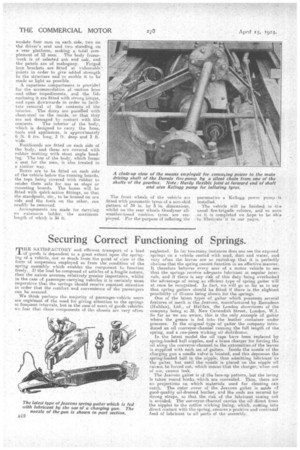Securing Correct Functioning of Springs.
Page 12

If you've noticed an error in this article please click here to report it so we can fix it.
THE SATISFACTORY and efficient transport of a load of goods ie dependent to a great extent upon the springing of a vehicle, -not so much from the point ofview of the form of suspension employed as from the condition of the spring assembly which enables the component to function freely. lithe load be composed of articles of a, fragile nature; then the axiom assumes relatively greater importance, whilst in the case of passenger-carrying vehicles it is certainly most imperative that, the springs should receive constant attention in order that the comfort and convenience of the passengers can be assured.
. We think perhaps the majority of passenger-vehicle users are cognizant of the need for giving attention to the springs at frequent intervals, but in the case of users of goods vehicles we fear that these components of the chassis are very often neglected. In far tooemany instances dues one see the exposed springs on a vehicle coated with mud, dust and wafter, and very often the leaves are so rusted-up that it is perfectly obvious that the spring cannot function in an effective manner. It therefore behoves every user of a motor vehicle to see that the springs 'receive adequate lubricant at regular intervals, and if there is any risk of this duty being overlooked the advantage of using an efficient type of spring gaiter will at once be recognized. In fact, we will go so far as to say that spring gaiters should be fitted if there is the slightest possibility of ill-care being liewn for the wirings. One of the latest types of gaiter which possesses several features of merit is the Jeavons, manufactured by Ramsdens (Halifax), Ltd., of Halifax, the London showrooms of the company being at 35, New Cavendish Street, London, W.1. So far as we are aware, this is the only ,example Of, gaiter where the grease is fed into the leather container under pressure. In_ the original type of gaiter the company introduced an oil conveyor-channel running the full length of the spring, and a one-piece wicking oil distributor.
In the latest model the oil caps have been replaced by spring-loaded ball nipples, and a brass charger for forcing the oil along the conveyor-dhannel to the extremities .of the leaves is supplied with each set of gaiters. Inside the nozzle of the charging gun a needle valve is located, and this depresses the spring-loaded ball in the nipple, thus admitting lubricant to the gaiter, but until the nozzle is placed.on the nipple oil cannot be forced out, which means that the charger, vslien out of use, cannot leak. The Jeavons gaiter is of the lace-up pattern, but the lacing is taken round hooks which are concealed. Thus, there are no projections on which materials used for cleaning can catch. The outer cover of the deavons gaiter is made of good-quality oil-dressed leather, and the ends Are secured by strong straps so that the risk of the lubricant oozing out
is avoided. straps, so carries the oil direct from the nipples to the cotton wicking lining, which, coming into direct contact with the spring, ensures a positive and•contintial feed of lubricant to all parts of the assembly,






























